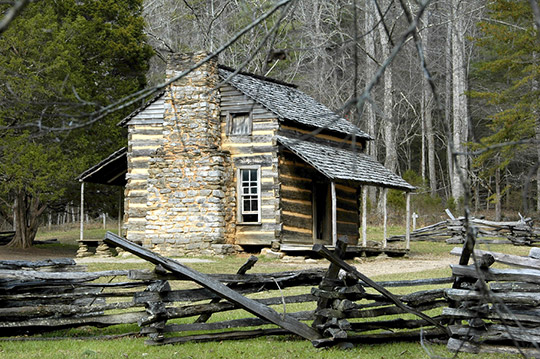Pioneer Weather
Weather was a very important part of daily life for farmers and homesteaders in the early years of our country. You’ve just learned how we measure weather today using instruments, computer models, satellites and advanced technology. But how did the pioneers go about measuring weather conditions?
Read the following passage and answer the questions that follow.

John Oliver Cabin: Cades Cove, TN | EyeMark/Bigstock.com
While the earth was defended from the rays of the summer sun, and protected from the cold blasts of winter by an impenetrable covering of fallen leaves, and a thick growth of forest trees, there can be no doubt of the winters being milder, and summers more temperate than at present. It was especially noticed in the summer nights, which were so cool as to render a blanket both a pleasant and desirable covering to the sleeper. The earth, when protected by the forest from the influence of cold winds, and covered with a thick coat of fallen leaves, never froze; while in an adjacent cleared field it froze to the depth of several inches. The warm vapour constantly rising from the earth, served to temper the atmosphere and render it more mild than at present….It is true there were some very cold winters and deep snows, but they were not so changeable as now: nevertheless it yet remains certain, that the winters are much more uniform, while a country is covered with forest, and not subject to such sudden changes of temperatures as they are in an open region….The summers are as much changed as the winters: fifty years since, they are more humid, and there was more generally that conditions of the atmosphere which we call sultry, and now experience in warm weather after a heavy rain. This constant humidity of the air was occasioned by the regular evaporation of moisture from the leaves of the trees, shrubs, and plants that clothed the face of the earth, and shut out the drying influence of the sun and air.
The same causes kept the surface constantly moist, and afforded a regular supply of water to the springs, during the summer as well as the winter, protecting the tender roots of the grasses and other plants from the cold, caused them to vegetate early in the spring, and bring forth a plentiful supply of herbage for the wild animals of the forest, and domestic cattle of the new settler.
Samuel Hildreth, Pioneer History, 1857
Hildreth, Samuel P. Pioneer History. 1848. Reprint. London: Forgotten Books, 2013. 521-2. Print.